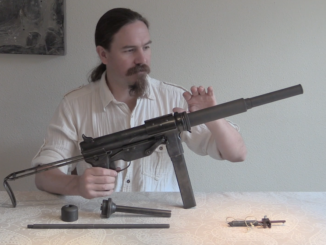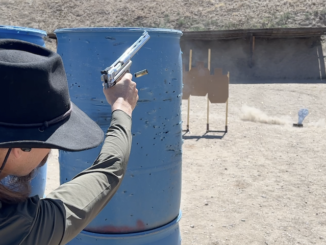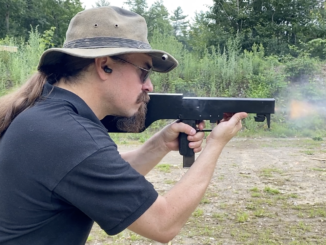“Pinto” is a name given to a specific sort of Smith & Wesson revolver by collectors. It refers to guns – typically J-, K-, and N-frame revolvers but all some semiauto pistols – produced with a mix of blued and nickeled parts. The name derives from the Pinto horse, which has patches of white and color. The guns were generally old as a way to use up excess parts from different production runs, but they have acquired a niche collector interest.
Related Articles

Submachine Guns
Suppressed OSS M3 Grease Gun and Bushmaster Booby Trap Trigger
Today, we have a chance to take a look at a suppressed M3 “Grease Gun”, as purchased and issued by the Office of Strategic Services (the OSS; predecessor to the CIA). Thanks to its readily […]

Competition
New .44 AutoMag Behemoth at the BackUp Gun Match
Yesterday we were looking at the new resurrection of the AutoMag pistol, and today I have it out at the monthly BackUp Gun match. Is it appropriate to bring this behemoth of a pistol to […]

Submachine Guns
UC-9 at the Range
Yesterday we looked at the development and mechanics of the UC-9 folding sneaky submachine gun. Today we are out at the range with it – how does this thing actually handle? Well, actually better than […]

Ian, are you sure that “pintos” originated from parts overruns? I have heard this theory before but I’ve never seen any empirical data to support this. Smith & Wesson revolvers with “fancy” finishes have been documented back to the 1850’s, and I do wonder if this started with some customers/distributors asking for it.
From the first days of S&W, including the S&W Volcanics, multiple combination finishes were offered: silver/blue, nickel/blue, gold/blue, gold/silver/blue, and so on.
S&W’s Volcanics, and the Model 1, for example, came standard with a silver-plated brass frame with a blued barrel and cylinder; Full-blue guns became the standard starting with the later Model 1s, Model 1 1/2, Model 2, and Model 3, although ‘half-plate’ was offered in the earlier versions of the three smaller models (I don’t think that #3s were offered ‘standard’ that way, but some probably were made on special order). ‘Half-plate’ was a standard option in later ‘break-top’ guns (except for the Model 3), commonly a nickel frame with a blued cylinder and barrel. Full blue or full nickel was the standard after the late 19th Century, but S&W offered, and I believe still offers from the Custom Shop, ‘half-plate’ or ‘Pinto’ finishes well into the 20th Century.
You are quite correct. These were a special order or distributor request item from S&W, from time to time.
If anyone else here has seen and remembers the film “Electra Glide in Blue” (1973, now sort of a cult favorite): the motorcycle cop played by Robert Blake carried a reverse Pinto as a service sidearm, nickle barrel and cylinder on a blued frame, with a longer barrel. At the time of viewing I thought it was some kind of fashion statement (the character was short, ambitious, and flamboyant). Now I wonder if it wasn’t a practical matter, that a nickeled barrel and cylinder would hold up better to life in a holster than a blued one.
I do remember seeing “Electra Glide in Blue”, but it was a long time ago, and I don’t recall the pistol.
I have always thought the Combat Magnum with the 2 3/4 inch barrel is one of the coolest looking guns around, though I wouldn’t fancy touching off a .357 Magnum round through a barrel that short.
The revolver used in “Electra Glide in Blue” was a Colt Python with a 4″ barrel, with a nickel cylinder and barrel. So not just S&W producing Pinto guns it seems.
In one of Greg Rucka’s bodyguard universe novels, a character, a former NYPD detective, carried a blue Model 10, with a stainless sideplate, as he was LH and his had rusted from being in long contact with his hip.
The standard barrels were 2.5, 4, and 6″; 3″ was a custom order. Magnum loads are unpleasant in the 2.5″, mostly due to muzzle blast and flash, but I ‘qualified’ for years with one as a backup gun without undue difficulty.
The biggest drawback to the M19 with high-velocity, high-pressure .357 125gr loads is the damage that it causes to the forcing cone of the barrel over time; Lower-pressure 158gr rounds are not as much of an issue. Best practice with any K-frame S&W .357 is to fire mostly .38Special +P for training, and carry .357 for serious work.
John:
If you do that, surely you will get a big surprise when you touch off a magnum round in extremis? I would have thought .38+P would be a good round for one of these revolvers. Magnum rounds through a 2 3/4 inch barrel don’t make a lot of sense to me.
I preferred .357 medium-velocity loads, because excessive use of the shorter .38 Special in a .357 can cause residue buildup in the chamber which is a real PITA to remove.
That said, I qualified with a 2 1/2″ Colt Lawman MK III for a decade and never really noticed much extra muzzle signature even with full-power 158 grain JHPs.
cheers
eon
I was thinking about the same thing, but since we don’t get to carry our guns around here, I decided to remain silent…
On the same subject, I have read that you should carry the same loading you feel complete comfortable to shoot on the range, or even something slightly milder, just to be on the safe side if you ever have to fire your gun in anger. But then again, it’s completely theoretical for me.
That is the ‘standard,’ but at useful range of a short-barreled revolver, even with adjustable sights, the difference on a ‘first shot’ is negligible–and that’s the one that counts.
No, they don’t, actually. With such a short (2.5″) barrel, you lose virtually all of the increased velocity and energy of the Magnum round due to it being wasted as blast from the powder still burning as the bullet leaves the muzzle, so, frankly, .38 +P is both more pleasant and more practical.
John in AK:
If you do that, surely you will get a big surprise when you touch off a magnum round in extremis? I would have thought .38+P would be a good round for one of these revolvers. Magnum rounds through a 2 3/4 inch barrel don’t make a lot of sense to me.
Anyone else notice the damage on the left side of the frame (flare to the cylinder)? Just wondering how that could have happened. Or are my eyes deceiving me?